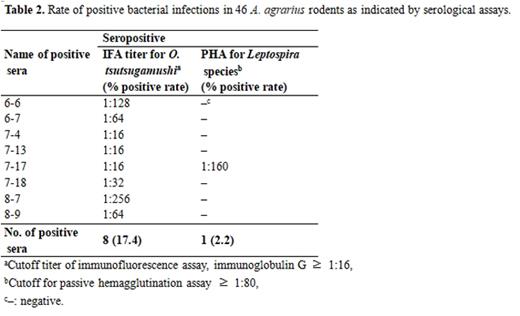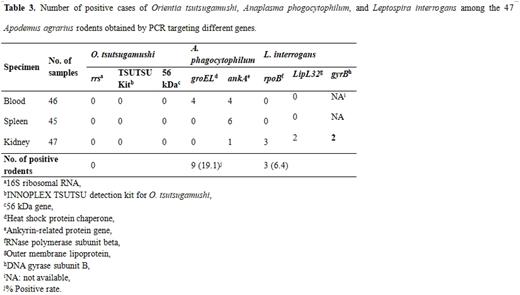-
PDF
- Split View
-
Views
-
Cite
Cite
Dong-Min Kim, Mi Seon Bang, Choon-Mee Kim, Na Ra Yun, Jun-won Seo, 1648. Prevalence of Orientia tsutsugamushi, Anaplasma phagocytophilum, and Leptospira interrogans in Striped Field Mice in Gwangju, Republic of Korea, Open Forum Infectious Diseases, Volume 6, Issue Supplement_2, October 2019, Pages S602–S603, https://doi.org/10.1093/ofid/ofz360.1512
Close - Share Icon Share
Abstract
Scrub typhus, anaplasmosis, and leptospirosis are well-known diseases that are considered common, widespread rodent-borne infectious diseases
This study investigated the prevalence of Orientia tsutsugamushi, Anaplasma phagocytophilum, and Leptospira interrogans in wild rodents through molecular detection using organ samples and through serological assay using blood samples of mice collected from two distinct sites in Gwangju Metropolitan City, Republic of Korea (ROK).
A total of 47 wild rodents, identified as Apodemus agrarius (A. agrarius), were captured from June to August 2016. The seroprevalence of antibodies against bacterial pathogens in A. agrarius sera was analyzed; 17.4% (8/46) were identified as O. tsutsugamushi through indirect immunofluorescence assay and 2.2% (1/46) were identified as Leptospira species through passive hemagglutination assay. Using polymerase chain reaction, the spleen, kidney and blood samples were investigated for the presence of O. tsutsugamushi, A. phagocytophilum, and L. interrogans. Out of the 47 A. agrarius, 19.1% (9/47) were positive for A. phagocytophilum and 6.4% (3/47) were positive for L. interrogans, while none were positive for O. tsutsugamushi. Four out of 46 (8.7%) blood samples, six out of 45 (13.3%) spleen samples, and one out of 47 (2.1%) kidney samples were positive for A. phagocytophilum. Three out of 47 (6.4%) kidney samples were positive for L. interrogans. The sequencing results of PCR positive samples demonstrated >99% similarity with A. phagocytophilum and L. interrogans sequences
A. phagocytophilum was mostly detected in the spleen, whereas L. interrogans was mostly detected in the kidneys. Notably, A. phagocytophilum and L. interrogans were detected in A. agrarius living in close proximity to humans in the metropolitan suburbans. The results of this study indicate that rodent-borne bacteria may be present in wild rodents in the metropolitan suburban areas of ROK



All authors: No reported disclosures.
Session: 163. Public Health
Friday, October 4, 2019: 12:15 PM
- polymerase chain reaction
- bovine anaplasmosis
- communicable diseases
- disclosure
- fluorescent antibody technique, indirect
- hemagglutination test
- leptospira
- leptospira interrogans
- leptospirosis
- orientia tsutsugamushi
- rodentia
- scrub typhus
- serologic tests
- antibodies
- bacteria
- kidney
- mice
- spleen
- pathogenic organism
- serum
- anaplasma phagocytophilum
- seroprevalence
- south korea





Comments